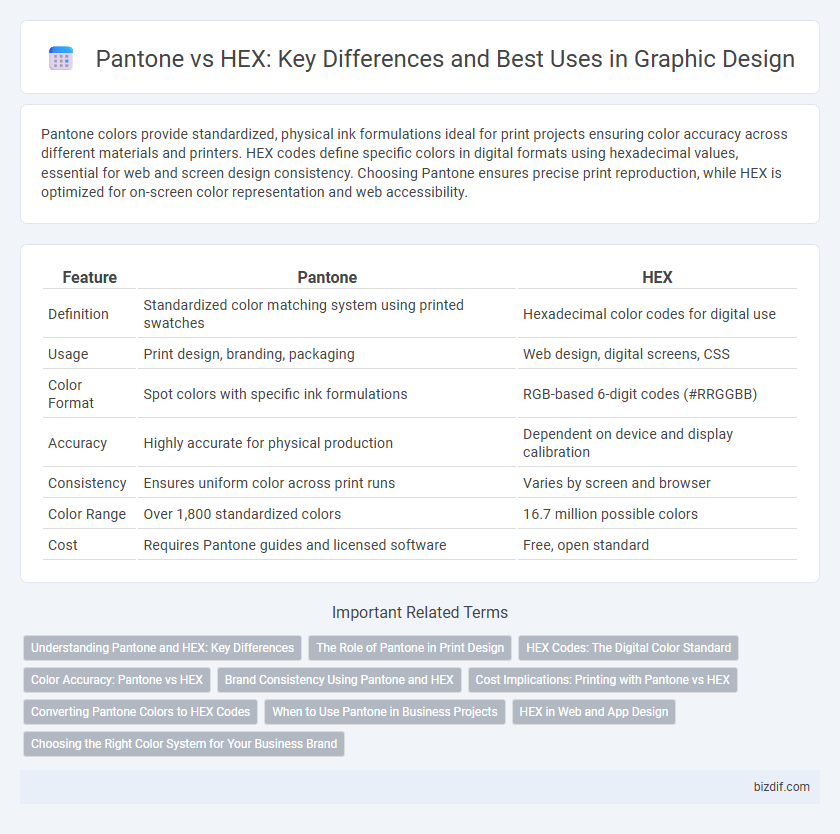Pantone colors provide standardized, physical ink formulations ideal for print projects ensuring color accuracy across different materials and printers. HEX codes define specific colors in digital formats using hexadecimal values, essential for web and screen design consistency. Choosing Pantone ensures precise print reproduction, while HEX is optimized for on-screen color representation and web accessibility.
Table of Comparison
| Feature | Pantone | HEX |
|---|---|---|
| Definition | Standardized color matching system using printed swatches | Hexadecimal color codes for digital use |
| Usage | Print design, branding, packaging | Web design, digital screens, CSS |
| Color Format | Spot colors with specific ink formulations | RGB-based 6-digit codes (#RRGGBB) |
| Accuracy | Highly accurate for physical production | Dependent on device and display calibration |
| Consistency | Ensures uniform color across print runs | Varies by screen and browser |
| Color Range | Over 1,800 standardized colors | 16.7 million possible colors |
| Cost | Requires Pantone guides and licensed software | Free, open standard |
Understanding Pantone and HEX: Key Differences
Pantone colors are standardized ink colors used primarily in print media to ensure consistent color matching across different materials and printers, defined by unique codes in the Pantone Matching System (PMS). HEX colors are six-digit, hexadecimal codes representing RGB values for digital screens, enabling precise color display on web and electronic devices. The key difference lies in Pantone's physical ink formulations versus HEX's digital color representation, making Pantone essential for print accuracy and HEX crucial for web and digital design.
The Role of Pantone in Print Design
Pantone colors provide standardized swatches crucial for achieving consistent print color accuracy across different materials and production runs, unlike HEX codes which are primarily used for digital color representation. The Pantone Matching System (PMS) enables designers and printers to communicate exact colors, ensuring brand integrity and precise color reproduction in print projects. This system is essential for print design workflows where color fidelity and predictability directly impact the final product's quality.
HEX Codes: The Digital Color Standard
HEX codes serve as the digital color standard in graphic design, representing colors through six-digit alphanumeric values that correspond to RGB (red, green, blue) combinations. Unlike Pantone, which is used primarily for physical printing and involves specific ink formulations, HEX codes are crucial for consistent color reproduction on digital screens and web interfaces. Mastery of HEX codes ensures precise color matching across various devices, enhancing user experience and brand identity in digital environments.
Color Accuracy: Pantone vs HEX
Pantone offers standardized color matching with precise ink formulations ensuring consistent color reproduction across different materials and printing processes. HEX codes represent colors digitally using RGB values but can vary in appearance depending on screen calibration and lighting conditions. For projects requiring exact color accuracy in physical media, Pantone is the preferred choice, while HEX is ideal for web and digital interfaces.
Brand Consistency Using Pantone and HEX
Pantone colors provide precise and standardized color matching critical for maintaining brand consistency across print materials, ensuring that hues remain uniform regardless of the printer or substrate. HEX color codes are essential for accurate digital brand representation, enabling consistent color display across various screens and web platforms. Integrating both Pantone and HEX values allows brands to achieve seamless visual identity continuity between physical and digital media.
Cost Implications: Printing with Pantone vs HEX
Printing with Pantone colors often incurs higher costs due to proprietary inks and the need for specialized mixing, making it ideal for brand consistency and high-quality spot color reproduction. HEX colors, primarily used in digital design, indirectly affect printing expenses by requiring conversion to CMYK or Pantone equivalents, which can introduce color variation and additional proofing costs. Choosing Pantone can increase upfront printing expenses but reduce the risk of costly color mismatches, while relying on HEX colors may lower initial costs but potentially impact final print accuracy and quality.
Converting Pantone Colors to HEX Codes
Converting Pantone colors to HEX codes requires understanding the distinct color systems: Pantone is a standardized color matching system used primarily in print, while HEX codes represent colors in digital formats using RGB values. Accurate conversion depends on brand guidelines and color accuracy tools, as Pantone's spot colors often have no exact digital equivalent and require approximation through software or color libraries. Designers rely on conversion charts, Pantone's official tools, or specialized design software like Adobe Illustrator to achieve the closest possible HEX representation of Pantone shades for web and digital use.
When to Use Pantone in Business Projects
Pantone colors are essential in business projects requiring precise color matching across different materials, ensuring brand consistency in logos, packaging, and printed marketing collateral. Unlike HEX codes, which are optimized for digital displays, Pantone provides standardized ink formulations that guarantee accuracy in print production and fabric dyeing. Use Pantone when exact color reproduction is critical to maintain brand identity and professional presentation in physical products.
HEX in Web and App Design
HEX color codes are essential in web and app design due to their precision in representing colors on digital screens. Unlike Pantone, which is primarily used for print, HEX codes define colors through a six-digit hexadecimal format that aligns seamlessly with HTML and CSS coding standards. This ensures consistent color rendering across various devices and browsers, enhancing user interface aesthetics and usability.
Choosing the Right Color System for Your Business Brand
Selecting between Pantone and HEX color systems depends on your brand's application needs and consistency requirements. Pantone offers precise color matching ideal for print and physical products, ensuring uniformity across materials. HEX colors are optimized for digital platforms, providing flexibility and ease of use in web design and online branding initiatives.
Pantone vs HEX Infographic

 bizdif.com
bizdif.com